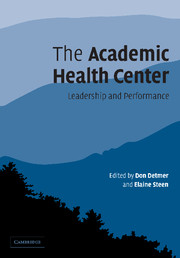Book contents
- Frontmatter
- Contents
- List of figures
- List of tables
- Foreword
- Acknowledgments
- List of contributors
- Introduction
- 1 Academic health centers: current status, future challenges
- 2 A health system for the twenty-first century
- 3 Stronger leadership in and by academic health centers
- 4 Pursuing organizational and cultural change
- 5 Managing and leveraging organizational knowledge
- 6 e-Health challenges and opportunities
- 7 Organizational challenges facing the European academic health center
- Index
- References
5 - Managing and leveraging organizational knowledge
Published online by Cambridge University Press: 12 November 2009
- Frontmatter
- Contents
- List of figures
- List of tables
- Foreword
- Acknowledgments
- List of contributors
- Introduction
- 1 Academic health centers: current status, future challenges
- 2 A health system for the twenty-first century
- 3 Stronger leadership in and by academic health centers
- 4 Pursuing organizational and cultural change
- 5 Managing and leveraging organizational knowledge
- 6 e-Health challenges and opportunities
- 7 Organizational challenges facing the European academic health center
- Index
- References
Summary
Introduction
Enabled by technological developments and accompanied by an economy undergoing fundamental changes, the knowledge age has arrived. Its impact is already evident in the nature, scope, and pace of competition among businesses, work of individuals, and expectations of the public. As this new era unfolds, organizations are assuming new roles, acquiring new capabilities, developing new business models, and interacting with consumers in different ways. Simultaneously, a flood of advances in the ability to preserve health and treat disease is creating exciting prospects and greater challenges for health care organizations and professionals and their patients.
At first glance it might appear that as institutions with a strong tradition of discovering and sharing knowledge, academic health centers (AHCs) would automatically become leaders of the health domain within the emerging knowledge economy. In fact, however, this leadership position is not assured. Academic health centers have been surpassed by other industries in the practices used to manage and leverage knowledge. They face growing competition in the discovery of new knowledge and are being challenged for the role of preferred source of health knowledge. Moreover, they must update their educational models for effectiveness in the digital era. Thus, AHCs need to attend to their organizational knowledge capabilities and to their role in the future health care environment.
Academic health center leaders face the pressing and pivotal question of how to position their organizations for future success.
- Type
- Chapter
- Information
- The Academic Health CenterLeadership and Performance, pp. 188 - 239Publisher: Cambridge University PressPrint publication year: 2005



